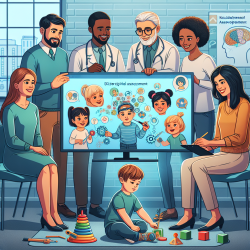Introduction
In the ever-evolving field of child development, practitioners are constantly seeking innovative methods to enhance their assessment capabilities. The research article "Converging Disciplines for Assessing Child Development" offers a compelling case for interdisciplinary collaboration as a means to develop scalable and valid assessment tools. This blog post delves into the key findings of the research and explores how practitioners can implement these insights to improve their skills and encourage further research.
The Challenge
The global challenge of ensuring that children reach their full developmental potential is formidable. Despite the accumulation of evidence on effective interventions, the absence of pragmatic and valid tools for assessing early life neurodevelopment remains a significant barrier. This challenge is exacerbated by the reliance on costly proprietary tools and the scarcity of highly trained child development experts, particularly in low- and middle-income countries.
Interdisciplinary Innovation
The research team, comprising experts from global mental health, developmental pediatrics, neuroscience, and computer science, set out to bridge this gap by developing digital assessment tools. Their approach involved digitizing and gamifying neuropsychological tests to be administered on low-cost Android tablets, allowing for direct assessments of a child's developmental capabilities.
These tools leverage the potential of digital technology, including computer vision analysis and portable EEG, to provide scalable assessments that can be delivered by frontline workers in home settings. This innovative approach not only makes assessments more accessible but also enhances their validity and reliability.
Overcoming Challenges
Collaboration across diverse disciplines presented challenges, such as differing concepts and vocabularies. The team overcame these obstacles by emphasizing the value of each perspective and ensuring representation of all disciplines at every stage of the project. This collaborative effort resulted in the creation of the Developmental Assessment on an E-Platform (DEEP) and the Screening Tools for Autism Risk using Technology (START).
Practical Implications for Practitioners
For practitioners in the field of child development, the research highlights several practical implications:
- Embrace Interdisciplinary Collaboration: Engage with professionals from various disciplines to enhance the development and implementation of assessment tools.
- Leverage Digital Technologies: Utilize digital platforms and tools to conduct assessments, making them more accessible and scalable.
- Focus on Community Engagement: Involve community partners and target audiences in the design and implementation of assessment tools to ensure their relevance and effectiveness.
Encouraging Further Research
The research underscores the importance of ongoing collaboration and innovation. Practitioners are encouraged to explore new opportunities for interdisciplinary research and to participate in capacity-building initiatives that cut across traditional disciplinary silos. By doing so, they can contribute to the development of more effective and inclusive assessment tools that address the complex challenges of child development.
Conclusion
The research presented in "Converging Disciplines for Assessing Child Development" offers valuable insights for practitioners seeking to enhance their skills and improve child development assessments. By embracing interdisciplinary collaboration and leveraging digital technologies, practitioners can play a pivotal role in advancing the field and ensuring that all children have the opportunity to reach their full potential.
To read the original research paper, please follow this link: Converging disciplines for assessing child development.










